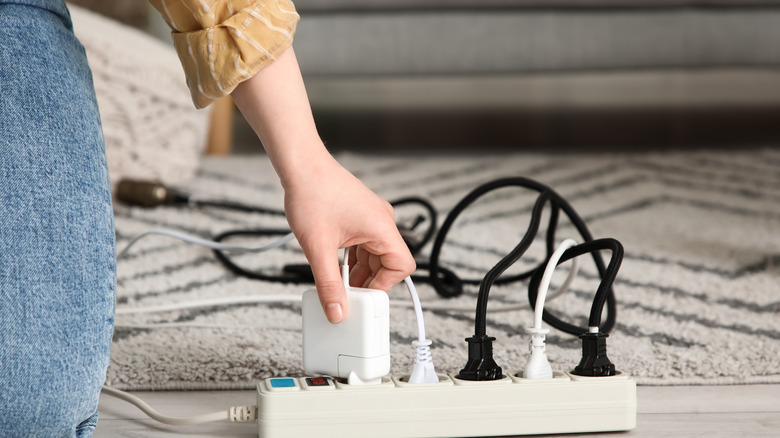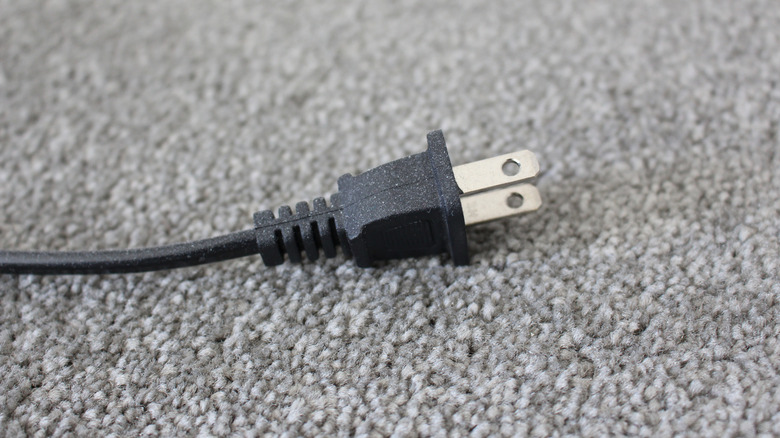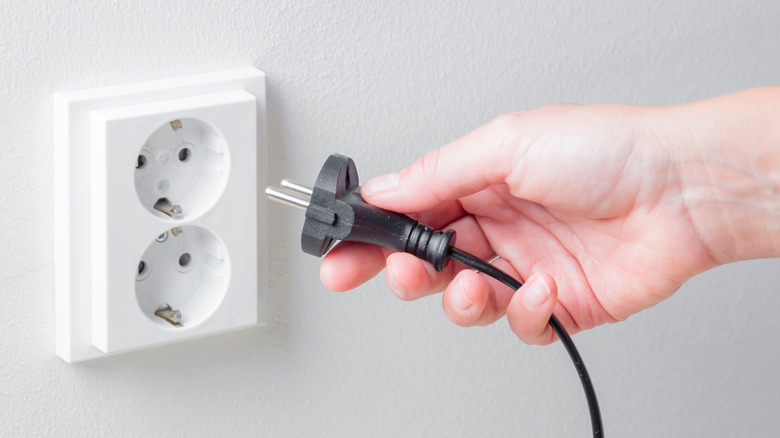Why You Should Think Twice About Running Power Cords Under Carpets
Exposed power cords can significantly impact your home's appearance. They can give your house a cluttered appearance, making it look a bit disorganized. Plus, visible power cords can pose a safety threat, so it's in your best interest to hide them properly to prevent fire hazards. At first, you might assume that hiding those cords neatly under a rug or carpet is a perfect solution. It will reduce visual clutter in your living room and minimize tripping hazards. However, running extension cords under a rug or a carpet — which seems harmless — is one of the common extension cord mistakes you should avoid.
According to the Consumer Product Safety Commission, an estimated 4,600 residential fires in the U.S. originate from power cords each year, and tucking the cords under carpets only increases that risk. How? Covering a cord with a rug means that you'll trap the heat. And when you add friction and pressure caused by foot traffic and furniture pressing down to the mix, the heat builds up, setting the stage for short circuits and, worse, fires.
What are the hidden risks of putting a rug over a cord?
Safety is crucial when it comes to power cords (whether it's extension cords, surge protectors, or heavy-duty power strips), and it starts by ensuring that the cords have adequate ventilation. After all, it's normal for cords to generate heat (especially when you plug in appliances that shouldn't be used in an extension cord). Sure, the heat dispersed might be harmless, and the cord might look fine. However, when you cover the cord with a rug, you block airflow, and the heat will accumulate at a rapid rate. Over time, the cords will overheat, and before you know it, the outer insulation will have degraded, leaving you with a fire hazard smoldering beneath your feet.
Physical damage is also another huge risk. Foot traffic across a carpet might not seem like much, but every step adds pressure to the cord, which can gradually wear down its outer casing. And since the damage will happen slowly, you'll hardly notice when the wires become naked, and this can be a recipe for short circuits, shocks, and fires. Lastly, beyond these safety concerns, there are the legal and financial implications. Most building and electrical codes explicitly prohibit running power cables under rugs or carpets. So, if you put a rug over a cord and, unfortunately, a fire breaks out, you might be denied your insurance claim because you've violated basic fire safety codes.
Safer ways to run power cords around your home without risking your safety
Just because it's risky to hide power codes under carpets, it doesn't mean you should live with messy, tangled cables. Luckily, there are so many things you can do to prevent cords from running throughout your floor. One easy trick is to use purpose-built cord covers and cable protectors. You can mount these rubber and plastic channels along walls and even on walkways, and they'll keep your wires organized (all while allowing proper airflow to prevent overheating). They'll also eliminate tripping hazards and keep cords visible for regular inspection.
Another thoughtful trick is to rearrange your furniture. You can place a sofa against the wall to hide cords running to a lamp or use decorative baskets to hide power strips. And the best part is that it's a simple approach that won't cost a dime. Plus, it will deliver more functional room designs. You can even consider installing additional power outlets to eliminate those tangled nests of extension cords.
In some situations, you can opt to leverage technology. Many devices today — from Bluetooth speakers to reading lamps — have battery-powered or wireless versions that eliminate the need for cords. And while you'll still need to charge these devices occasionally, removing even a few permanent cords from your floor will make a huge difference. Just be sure to pick the right extension cords (those explicitly rated for your equipment's power demands), and then protect the cords with proper covers designed to withstand foot traffic.


